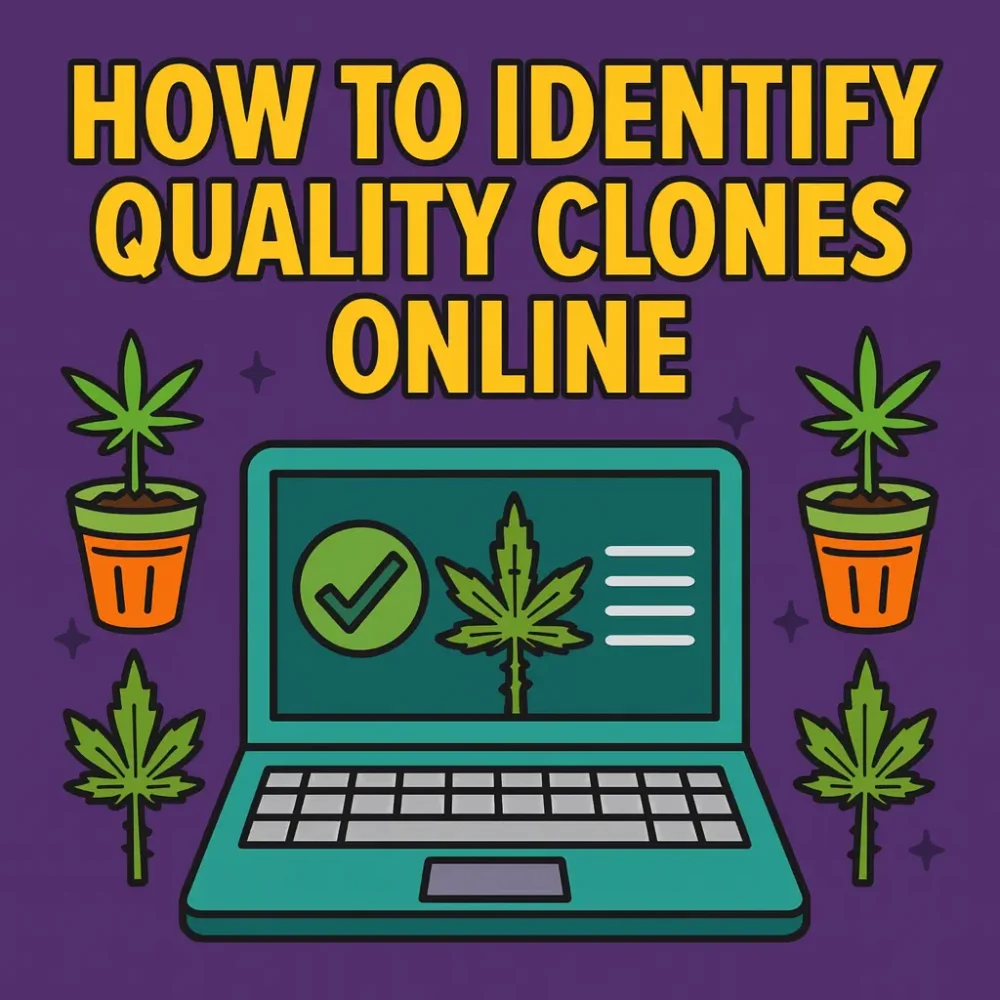Updated August 2025
How to Identify Quality Clones Online 🔍
Shopping for clones online can feel like a gamble. Some vendors deliver vibrant, pest-free genetics that explode in the grow room. Others ship half-dead sticks that never recover. This guide helps you separate the winners from the red flags so your money goes toward strong, authentic cannabis plants every time.
🌿 Why Clone Quality Matters
Cannabis is one of the few crops where a bad start can erase months of effort. Buy a clone with hidden pests or Hop Latent Viroid, and you might not realize it until flower—when it’s too late to save the run. By contrast, strong, clean clones give you a head start, shorten veg, and make harvest planning predictable.
👀 Visual Signs of a Healthy Clone
Before you even ask about lab testing or lineage, a clone should pass the eye test. When unboxing, look for:
- Leaf Color: Bright green, no drooping, spotting, or necrosis.
- Stem Strength: Thick enough to stand upright, not floppy or spindly.
- Roots: White and fibrous, peeking from the plug. Brown or slimy roots = discard.
- Overall Shape: Compact and bushy with multiple nodes—stretched clones signal poor lighting.
Think of it like picking fruit at the market: if it looks tired, it probably won’t get better at home.
🧬 Genetic Authenticity
The hottest names—Runtz, Gelato, Wedding Cake—are also the most counterfeited. Any seller can slap a famous strain name on a random cut. What sets real vendors apart is transparency:
- They list breeder info (e.g., Symbiotic, Seed Junky).
- They disclose lineage (e.g., Gelato 41 × Zkittlez for Runtz).
- They provide photos of finished flower grown from their mother plants.
🧪 Pathogen & Pest Testing
HLVd alone has wiped out entire grow facilities. Powdery mildew spreads invisibly on clone leaves. The only way to avoid these disasters is pathogen-screened stock. Leading vendors now test their mothers at accredited labs and display results publicly.
Key diseases to ask about:
- Hop Latent Viroid (HLVd)
- Powdery Mildew
- Tobacco Mosaic Virus (TMV)
Healthy leaves mean nothing if a hidden virus is in the tissue. Pathogen screening is the new industry standard.
📦 Packaging & Shipping Standards
Even the best clones die if they bounce around in a hot truck for three days. Quality vendors know this and use:
- Breathable but secure vented boxes to prevent mold.
- Rockwool or peat plugs wrapped to hold moisture.
- Cold packs in summer, insulation in winter.
- Shipments sent early week (Mon–Wed) to avoid weekend delays.
⭐ Seller Reputation & Reviews
Before clicking “buy,” look beyond the seller’s site. Search their name on forums, Reddit threads, or Discord groups. Good clone vendors don’t just sell—they’re part of the community. Watch for:
- Grow logs from customers showing harvest results.
- Replacement guarantees for failed clones.
- Consistent communication and tracking updates.
Reputation is hard to fake over time. If growers trust them season after season, you probably can too.
⚠️ Red Flags When Buying Online
Not every online seller is trustworthy. Common warning signs include:
- Stock photos instead of actual clone pictures.
- Overly cheap pricing—elite clones rarely go for “bargain bin” rates.
- Zero info about mother plants or breeders.
- No return/replacement policy for dead arrivals.
❓ FAQ: Identifying Quality Clones Online
How do I know if a clone is healthy?
Look for upright stems, vivid green leaves, and bright white roots coming out of the cube. If you see yellowing or wilting, steer clear.
Can I trust online clone photos?
Yes, but only if the seller also posts grow logs, customer reviews, or finished flower photos. A single stock image is not enough proof.
What’s the #1 question to ask a seller?
“Do you test for Hop Latent Viroid?” If the answer is vague, avoid them. HLVd is the silent killer of modern cannabis grows.
Do clones survive shipping well?
With proper packaging, yes. The best vendors use insulated boxes and only ship early in the week to avoid weekend delays.
Why do elite clones cost more?
Because they’re backed by proven mother plants, breeder authenticity, and pathogen testing. You’re paying for reliability, not just a cutting.
Should I quarantine new clones?
Always. Keep new arrivals in a separate tent for 1–2 weeks before introducing them to your main grow. This prevents hidden pests from spreading.

